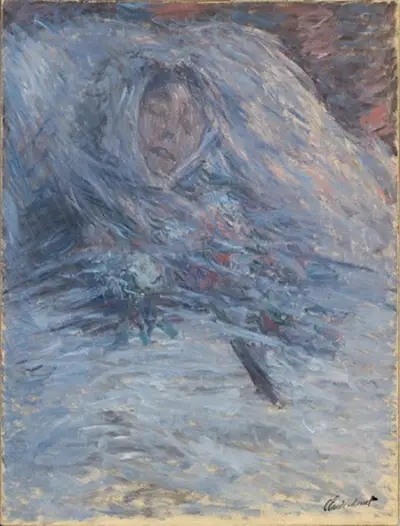The inspiration for the piece was Claude's wife, Camille Monet. This piece is considered one of the most powerful pieces the artist did of the wife.
Monet used shades of pink and blue to bring the portrait to life, so to speak. Claude Monet worked on the painting of his wife while she was lying in bed, suffering from a terminal illness. Every brush stroke in the painting is reflective of the artist’s true style and his emotions during the time.
Camille's face is shrouded in a veil that adds to her grave look. Her eyes, though closed and her lips don't hide her imminent death. She is covered in blue fabric that seems to absorb her entire body. A few strokes along the edge provide the only bright tones of the painting.
The serene surroundings magnify the calmness of the subject without taking away her presence. It is possible to outline a bouquet of flowers laying on Camille's chest, which reinforces the somber mood.
The impressionism of Camille Monet on Her Death Bed resembles the water lily paintings that Monet is famous for. Its particular shades of blue and gray remind a spectator of Impression, Sunrise (1872).
When commenting on the portrait some forty years later, Claude is quoted saying, 'I found myself staring at the tragic countenance, trying to identify the shades in the color, the proportion of light and the sequence.'
He said he saw shades of blue, yellow and gray and before 'the thought occurred to me to memorise the face that had meant so much to me,' his first reaction was to tremble at what he saw in the colours.
The art piece never went to exhibit when Claude was alive, and he never signed it. The signature that is clearly visible at the bottom right was stamped on after his death.
Camille Monet as a Subject
Camille Monet on Her Death Bed is one of many pieces where Claude used his wife as a muse. In fact, a good number of Monet’s top paintings feature his wife and in later years, his wife and son. Some examples of such artwork include the Woman in a Green Dress (1866), Camille with a Small Dog (1866), and Madame Monet and a Child (1875).
Camille Leonie Doncieux began posing for Monet when she was a teenager. She was already an established model in Paris for various artists, and her work with Monet only elevated her status. Camille had worked with Edouard Manet and Pierre-Auguste Renoir.
It is said that she had a desire to enjoy an enriched life, which is one way she connected with Monet. They achieved that by Camille modeling the latest fashion in 19th century Paris while Monet put them on canvas. She was known as the Queen of Paris.
Camille Monet fell ill in 1877, the year before delivering her second son. Some speculate that she had cervical cancer, which had gotten worse when she refused to receive surgical treatment.
Her pregnancy also aggravated her condition. She was 32 when she died. Five days before her passing, Claude brought a priest to consecrate their marriage because they had only had a civil union.
The piece, Camille Monet on Her Death Bed, depicts the sorrow of a husband and father. It is believed that the artwork, and the event set the stage for a major milestone in Monet's life.


